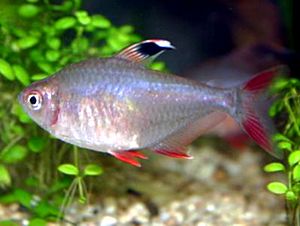Characiformes facts for kids
Quick facts for kids Characiformes |
|
|---|---|
 |
|
| Hyphessobrycon bentosi | |
| Scientific classification |
|
| Kingdom: | Animalia |
| Phylum: | Chordata |
| Class: | Actinopterygii |
| (unranked): | Otophysi |
| Order: | Characiformes Regan, 1911 |
| Families | |
|
|
Characiformes is a large group of fish. They are a type of ray-finned fish. This means their fins are supported by bony rays.
This group includes many well-known fish. Some examples are the famous piranha and colorful tetras. There are more than 2000 different kinds of Characiformes. They are organized into 18 recognized families.
Contents
What are Characiformes?
Characiformes are part of a bigger group of fish called Otophysi. This supergroup also includes three other fish orders. These are Cypriniformes, Siluriformes (catfish), and Gymnotiformes.
Characiformes, Siluriformes, and Gymnotiformes form a special subgroup. It is known as the Characiphysi. Scientists often study how these groups are related.
How are Characiformes Classified?
At first, all characins were put into one big family. This family was called Characidae. But over time, scientists found many differences. So, they separated them into 18 different families.
However, how they are classified can still change a bit. A recent study from 2011 confirmed that the Characidae family is a monophyletic group. This means they all came from a single common ancestor.
Today, we know of 18 families in this group. There are also about 270 different genera. And at least 1674 species have been identified.
Where Did Characiformes Come From?
The oldest known characiform is a fish called Santanichthys. It lived a very long time ago. This was during the early Cretaceous period in Brazil.
Today, all living Characiformes are freshwater fish. But Santanichthys might have lived in salty or brackish water. Many other fossils of these fish have also been found.
Characiformes probably started to become very diverse during the Cretaceous period. This was when the continents of South America and Africa were splitting apart. This separation might explain why these fish are so different on the two continents.
What Do Characiformes Look Like?
Characins have a special body part called a Weberian apparatus. This is a series of bony parts. They connect the swim bladder to the inner ear. This helps them hear better.
They look a bit like their relatives in the order Cypriniformes. But Characiformes have a small, fleshy adipose fin. This fin is located between their dorsal fin (top fin) and their tail.
Most species have teeth in their mouths. This is because many of them are carnivorous, meaning they eat meat. Their bodies are almost always covered in clear, well-defined scales. Also, their mouths usually cannot extend forward very much.
How Big Do They Get?
The largest characins can grow quite big. Fish like Hydrocynus goliath, Salminus franciscanus, and Hoplias aimara can reach up to 1.2 meters (about 4 feet) long.
The smallest characin is tiny. It is the Bolivian pygmy blue characin, Xenurobrycon polyancistrus. It is only about 1.7 centimeters (less than an inch) long. Many members of this group are smaller than 3 centimeters (about 1.2 inches).
Where Do Characiformes Live?
Characins are most common in the Neotropics. This region includes most of South America and Central America. They live in lakes and rivers there.
For example, the red-bellied piranha is a type of characin. It is only found in the Neotropical region.
About 209 species of characins are found in Africa. These include fish from the distichodontids, citharinids, alestiids, and hepsetids families. All the other characins come from the Americas.
Characiformes and Humans
Some characins grow very large. These are important for food or for sport fishing. However, most characins are small fish that swim in groups.
Many species known as tetras are very popular in home aquariums. People like them because they have bright colors. They are also generally hardy and get along well with other fish in a community tank.
See also
 In Spanish: Characiformes para niños
In Spanish: Characiformes para niños

